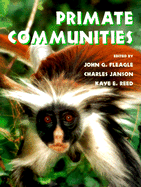Book contents
- Frontmatter
- Contents
- List of contributors
- Preface
- 1 African primate communities: Determinants of structure and threats to survival
- 2 Biomass and use of resources in south and south-east Asian primate communities
- 3 Species coexistence, distribution, and environmental determinants of neotropical primate richness: A community-level zoogeographic analysis
- 4 Primate communities: Madagascar
- 5 Primate diversity
- 6 Phylogenetic and temporal perspectives on primate ecology
- 7 Population density of primates in communities: Differences in community structure
- 8 Body mass, competition and the structure of primate communities
- 9 Convergence and divergence in primate social systems
- 10 Of mice and monkeys: Primates as predictors of mammal community richness
- 11 Comparing communities
- 12 Large-scale patterns of species richness and species range size in anthropoid primates
- 13 The recent evolutionary past of primate communities: Likely environmental impacts during the past three millennia
- 14 Resources and primate community structure
- 15 Effects of subsistence hunting and forest types on the structure of Amazonian primate communities
- 16 Spatial and temporal scales in primate community structure
- 17 Primate communities in Africa: The consequences of long-term evolution or the artifact of recent hunting?
- 18 The future of primate communities: A reflection of the present?
- 19 Concluding remarks
- Systematic index
- Subject index
16 - Spatial and temporal scales in primate community structure
Published online by Cambridge University Press: 21 August 2009
- Frontmatter
- Contents
- List of contributors
- Preface
- 1 African primate communities: Determinants of structure and threats to survival
- 2 Biomass and use of resources in south and south-east Asian primate communities
- 3 Species coexistence, distribution, and environmental determinants of neotropical primate richness: A community-level zoogeographic analysis
- 4 Primate communities: Madagascar
- 5 Primate diversity
- 6 Phylogenetic and temporal perspectives on primate ecology
- 7 Population density of primates in communities: Differences in community structure
- 8 Body mass, competition and the structure of primate communities
- 9 Convergence and divergence in primate social systems
- 10 Of mice and monkeys: Primates as predictors of mammal community richness
- 11 Comparing communities
- 12 Large-scale patterns of species richness and species range size in anthropoid primates
- 13 The recent evolutionary past of primate communities: Likely environmental impacts during the past three millennia
- 14 Resources and primate community structure
- 15 Effects of subsistence hunting and forest types on the structure of Amazonian primate communities
- 16 Spatial and temporal scales in primate community structure
- 17 Primate communities in Africa: The consequences of long-term evolution or the artifact of recent hunting?
- 18 The future of primate communities: A reflection of the present?
- 19 Concluding remarks
- Systematic index
- Subject index
Summary
The chapters in the preceding section have reviewed evidence that the present structure of primate communities is affected by resource abundance (Janson & Chapman, chapter 14, Peres, chapter 15), food quality and digestive strategies (Janson & Chapman), seasonality (Janson & Chapman; Tutin & White, chapter 13), disease (Tutin & White), contemporary hunting (Peres), recent land-use history (Tutin & White), climatic change in the recent past and the Pleistocene (Tutin & White; Eeley & Lawes, chapter 12), and regional species source pools (Eeley & Lawes; Peres). Despite the diversity of these themes, they fall into two broad contrasts which we shall use to review the preceding results: (1) local vs. regional explanations of primate community structure; and (2) equilibrial vs. nonequilibrial views of community structure.
LOCAL VS. REGIONAL DETERMINANTS OF PRIMATE COMMUNITY STRUCTURE
There is a tension between explanations that rely on local versus regional ecological factors to explain local site diversity. Local factors include resource abundance and quality, seasonality, competition and contemporary hunting. Regional analysis focuses on regional source pools of species – a local site cannot have a primate species that is not in the regional source pool. This distinction is essentially parallel to that between alpha-and gamma-diversity in community ecology. Alpha-diversity reflects the number of coexisting species in a single site, whereas gamma-diversity includes additional species that may replace each other in separate areas of similar habitat only because of geographical isolation. Proponents of local factors find support in the fact that primate population densities predictably increase in areas of greater soil fertility (Peres), high food quality (Janson & Chapman), and low hunting pressure (Peres).
- Type
- Chapter
- Information
- Primate Communities , pp. 284 - 288Publisher: Cambridge University PressPrint publication year: 1999
- 4
- Cited by



